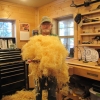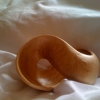Whether you're adding that inside bevel or just cleaning off the burr, you need as much contact as possible between slipstone and curved metal to work most efficiently.
Multiply gouge sweeps by widths and you have a big number of possible inside curves - but look at what shapes and sizes of carvers' slipstones are available - if you can find them - and you'll find the possibility of fitting that inside surface efficiently is quite limited. You find yourself vigorously trying to cover the inside of a flat gouge with a rounded slipstone, or not finding a slipstone narrow enough to get within a small fluter or veiner.
The special carvers' slipstones I designed with Norton India try to address this issue, but they can only go so far. What to do? Most carvers don't think of this but you can change the slipstone! Shape its edge to have better contact with the metal. Slim it down to fit inside that narrow little gouge. You can also dress the worn surfaces of those slipstones that do fit. Any slipstone you buy can be modified to something more useful. It's easy and I'll show you how.
Note: At the end of the video you see me praising my newly shaped slipstone for a good fit when, from the camera's point of view, it obviously could be better! That was the problem: working this to camera rather than pulling the tool back so I could see the fit more clearly, which I did when Carrie went away... But, hey, you'll get the message: it's not a big deal to change the shape of your slipstones.

| 22 November 2019 19:55
Thankyou l try make slipstone from my old waterstone.

| 21 November 2019 15:21
Noriko - I've never cut (or shaped) a waterstone but my guess is a hard, sharp object - something like a masonry nail - or hacksaw blade. You could easily create a deep groove around the stone and then snap it.

| 20 November 2019 21:28
what tool use cutting waterstone ?

| 14 August 2018 17:25
Rodney - It's the same principle as sanding a piece of wood: use a coarse paper such as 80grit to do the main shaping; move on to a middle, say 120; finish of with finer grit, say 180.

| 10 August 2018 03:24
As you are aware that I am deaf and I wondered what grit sandpaper is that?

| 02 May 2017 17:46
Karen - I start with 120 grit. Coarser will shape the slipstone quicker; finer slower and give a smoother surface.
If you use a file to shape, the file itself will suffer - the stone is harder than the file and will wear the file's cutting ridges away. Sandpaper is cheaper and more easily replaced. So use sandpaper. Wrap it around a piece of wood to create and ersatz file if you want.

| 01 May 2017 16:07
Chris,
What san paper grade are you using to shape the surface of the stone? I have a small chip in my Chris Pye series stone (a shipping issue that has been compensated nicely) - a rather irregular shape, approx. 1 inch long. Would it be better to use a file here or just play with the sandpaper until I can get the surface area smooth again. I will have to lower the chipped section of the stone as the chip sort of reminds me of nasty tooth decay.

| 20 November 2015 19:22
Thank you for your prompt answer. I saw the detail set of slipstones when I ordered the v-stone, but I was mistaken on the size of my v-tool. Anyway, I'll have to think about what I'll do - I'm in no hurry.
Thanks,
Liam

| 20 November 2015 08:08
Liam - You can shape and slipstones by rubbing it on something harder: benchstones, sandpaper on glass, files etc will all do it. If you are not using the larger slipstones then re-purposing them makes sense - although it's a lot of work and you might regret it later when you need them for the bigger tools. There is a 'detail' set of 4 slipstones which I designed for narrower tools in the same series - that might be a better answer; it includes a narrow V slip and others for small gouges.

| 18 November 2015 16:13
Hello Mr. Pye,
I recently purchased the slipstones and the 45/90 degree v-stone you designed with Norton. However, I have a small (about 3mm) #8 gouge and a 3mm 60 degree #12 v-tool that don't quite fit any of the edges. I was wondering whether or not it would be possible to shape the Arkansas slip-stone and v-stone.
Thanks,
Liam Hedrick

| 27 January 2014 16:01
Sean - There are 3 thicknesses of slipstone: 18, 10 and 6mm, as well as a 'detail' set at 3mm. When I designed them, I thought of each of the 4 edges as a gouge, profiled with the odd numbered sweeps : #3, 5, 7 and 9. So each thickness of stone should correcpond to the Sheffiled list in that regard. I have no control over the manufacturing and it may be that the sweeps 'drift' a little, thus it's quite important to be able to 'tune' these stones to suit.

| 26 January 2014 20:26
I have been looking at the your various signiture slip stone kits and trying to figure out which one (ones) would best suit my needs, ie. what profiles come on which stones (standard 1&2 , sculpture) specifically. Thanks

| 22 January 2014 09:24
Eric - I never even looked at the grit numbers! See it a bit like sanding wood? Start coarse for quick removal of material; finish off with fine sandpaper - that sort of thing...

| 22 January 2014 08:14
Awesome Chris! This is a great addition to the video library, Now to pick up all those flea market slip stones I have been neglecting.......

| 20 January 2014 17:02
Well Once again you took the Mystery out of it and made it look so simple. I've been wondering how to do this but was too scared to try and ruin my stone or my tools.

| 20 January 2014 15:35
Chris, any specs on the paper, type, grit, etc. Thanks

| 19 January 2014 09:31
This video is a gem! I've been wondering how to sort out slipstones I've picked up from car boot sales - someone suggested using an angle grinder which sounded both drastic and dangerous. Tried an old grinding wheel and that was so dusty - DO NOT try that at home! Chris has again come to my rescue with a method which is simple, will save me a bit of money but, more importantly, increased my confidence in my ability to maintain my tools. Thank you.